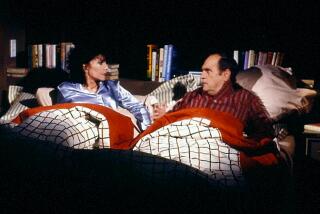They’re Not Just Playing Around
- Share via
CARROLLTON, Texas — Bob the Builder has stolen Barney’s spotlight.
The popular English construction worker, armed with his signature tool belt and hardhat, has hammered his way past the singing and dancing purple dinosaur and into the hearts of children around the world.
But although Barney’s popularity has plummeted since his heyday, he’s not giving up without a fight.
“Bob the Builder’s” creator, HIT Entertainment of London, acquired the company that produces “Barney,” Allen, Texas-based Lyrick Studios, last year for $275 million. The deal gave HIT a marketing and distribution network that it used to introduce Bob to U.S. audiences.
“HIT really needed a little bit of a push start in getting entrenched in the North America market. Lyrick needed the same thing across the Atlantic,” said Denise Perkins-Landry, a Lyrick veteran and now a spokeswoman for HIT.
Bob, whose computer-animated television show debuted to American audiences on the Nickelodeon network in January 2001--the month before the Lyrick deal--has since garnered acclaim among the preschool and elementary crowd.
Bob has become a sought-after toy and a favorite of trick-or-treating tykes. He even merited a float in the Macy’s Thanksgiving Day parade.
The computer-animated series is set in a construction yard, where Bob and gal pal Wendy meet each morning before going out on assignment for neighborhood characters. In cahoots with talking construction-yard equipment, Bob and friends spend 30 minutes illustrating their thematic can-do agenda.
Bob’s theme song “Can We Fix It? Yes, We Can!” in 2001 became Britain’s hottest-selling song since Elton John’s “Candle in the Wind.”
Distributed in more than 130 countries, “Bob” has sold more than 2 million videos, books and magazines and has a licensing agreement with Hasbro to market toys based on the show.
The buzz has even surprised “Bob’s” managers.
“We had high hopes, but in the economy we’re having right now, we are very fortunate to have the success we’ve been having,” said Holly Stein, who heads HIT’s marketing division.
Since the Lyrick acquisition, video sales of HIT properties have increased 33%, with Bob the Builder accounting for most of the increase, Perkins-Landry said. The company is on target to earn $40 million this year on sales of $150 million.
Though Barney’s popularity has declined, he’s still drawing a 6.6 rating among children ages 2 to 5, or 1,070,000 children, according to PBS’ season-to-date figures. That’s down from a peak 13.2 rating, or 2,080,000 children, in the 1996-97 season.
The falling television ratings might be blamed partly on the fact that Barney hadn’t filmed new episodes or completed a toy-licensing agreement in about five years.
Now Barney is undergoing a make-over. HIT has been busy producing new shows at the company’s Carrollton Studios slated for fall release on PBS, Barney’s television home since the show first aired in 1992.
The familiar playground set has been replaced by a park scene complete with $40,000 sycamore trees, a pond, gazebo and caboose. The cast of children is new. And producers have updated Barney’s act, giving him a laptop computer.
“Ratings have declined, but ratings are driven by adults, and this is about the children,” said Randy Dalton, executive producer of “Barney & Friends.” “I fully expect that Barney will be back at No. 1 when we premiere the new series.”
Besides the release of a new video and live-action tour, Barney also has sealed a licensing agreement with toy maker Fisher-Price, with products to be in stores as the new episodes debut.
“There will be a big Barney presence in front of the consumer for the first time in a long time,” Perkins-Landry said.
Despite the new set, cast and toys, Barney will find the television market has changed greatly since his start a decade ago. The number of children’s television productions has exploded, splitting the audience into more pieces.
And Barney still has his detractors.
“It’s so nauseatingly sweet; it turned me off right at the beginning,” said Peggy Charren, founder of Action for Children’s Television, which lobbied Congress for a 1990 law requiring local stations to serve children’s educational needs.
“There’s something too white-bread, too do-goody about it,” Charren said. “The children are too happy. They don’t look real. They look animated even though they’re not.”
Dalton, Barney’s executive producer, says Charren is missing the point.
“It’s not full of jokes and puns, it’s just entertaining, and it’s not for adults,” he said. “If adults loved it, we would be missing our target audience.”
More to Read
Inside the business of entertainment
The Wide Shot brings you news, analysis and insights on everything from streaming wars to production — and what it all means for the future.
You may occasionally receive promotional content from the Los Angeles Times.










